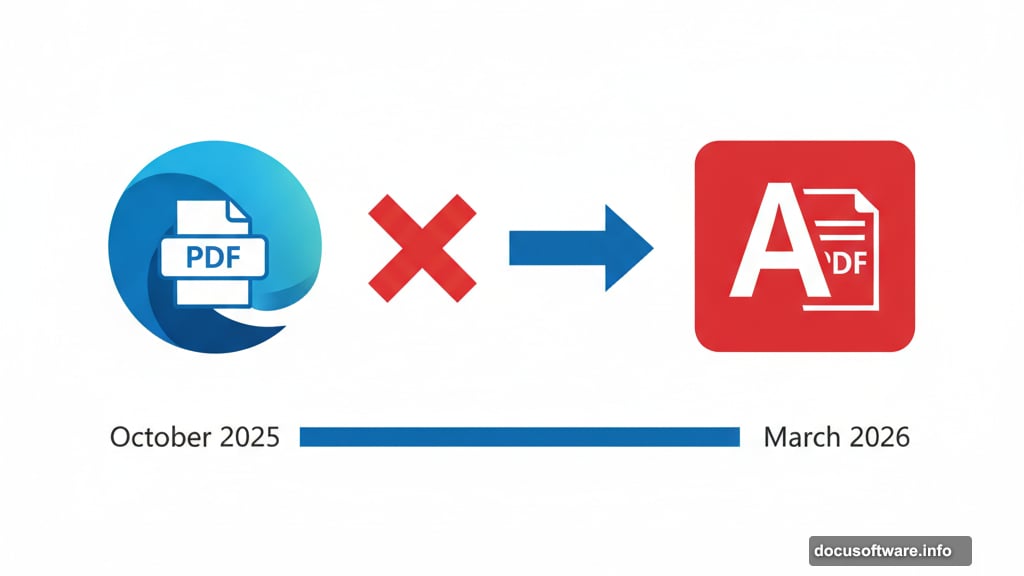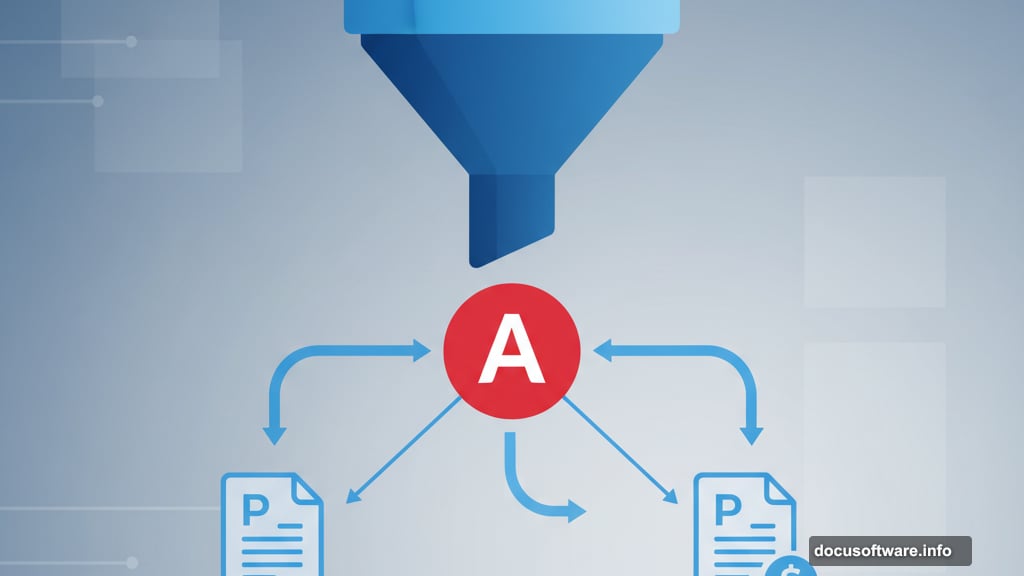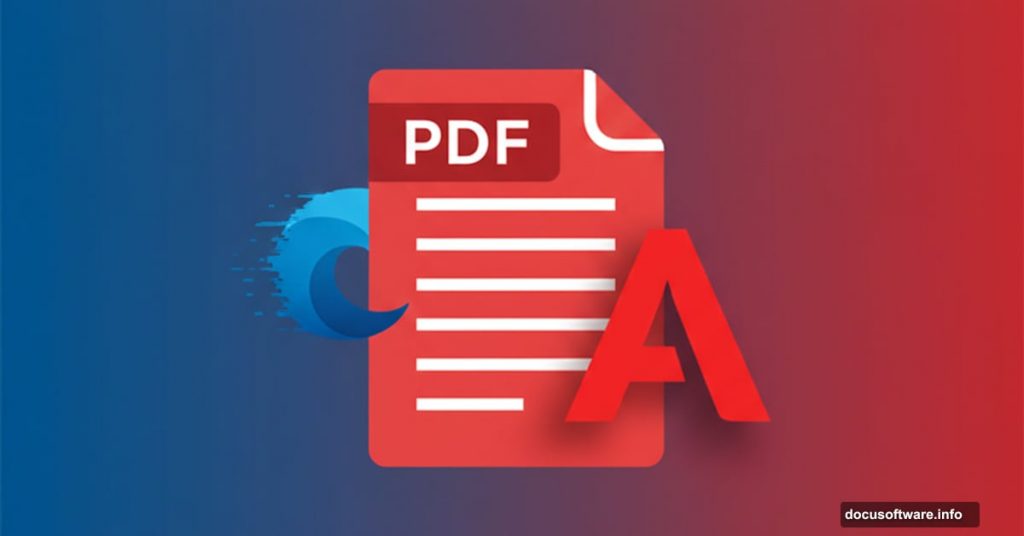Microsoft Edge is ditching its built-in PDF reader. Starting October 2025, every enterprise user on Windows will get Adobe’s PDF viewer instead.
This isn’t optional. This isn’t gradual. By March 2026, Adobe’s technology becomes the default PDF experience for 1.4 billion Windows users running Edge.
Let’s talk about what this actually means for your daily work.
What’s Actually Changing
Edge version 141 brings Adobe’s PDF engine directly into the browser. No extensions to install. No settings to configure. Just automatic replacement of Microsoft’s current PDF viewer.
Microsoft claims this delivers better performance, accessibility, and compatibility. Plus, enterprise users gain access to Adobe-exclusive features. But here’s what they’re not saying loudly: this fundamentally shifts control of PDF viewing from Microsoft to Adobe.
Think about how often you open PDFs in your browser. Contract reviews, documentation, reports, forms. Now all those interactions flow through Adobe’s technology instead of Microsoft’s.
Why Microsoft Made This Move
Microsoft doesn’t abandon features lightly. So why hand PDF viewing to Adobe?
Performance tells part of the story. Adobe built their reputation on PDF technology. They invented the format back in 1993. So their rendering engine handles complex PDFs better than Microsoft’s implementation.
But business strategy matters more. Adobe pays Microsoft for this integration. Meanwhile, Microsoft avoids maintaining a competitive PDF viewer while Adobe gets 1.4 billion potential customers exposed to their technology.
Both companies win. The question is whether users win too.
What Adobe Brings to Edge

Adobe’s viewer includes features Microsoft’s version lacks. Enterprise-focused capabilities like advanced form filling, digital signatures, and document comparison.
Plus, Adobe promises better compatibility with complex PDFs. Files with heavy graphics, intricate layouts, or embedded media should render more reliably.
However, Adobe’s viewer comes with Adobe’s ecosystem. Want to edit a PDF? That prompts Adobe Acrobat purchases. Need premium features? Adobe’s subscription appears.
Microsoft’s viewer was simpler but never pushed you toward paid upgrades. Adobe’s approach is more capable but also more commercial.
The Timeline That Matters
Rollout starts October 2025 with Edge version 141. Full deployment completes by March 2026. That’s a six-month window where enterprises might see mixed behavior across devices.
IT departments should prepare now. Test Adobe’s viewer with your most commonly used PDFs. Check compatibility with internal tools that generate or modify PDFs. Verify that workflows relying on specific PDF features still function.
Moreover, consider whether this change affects compliance requirements. Some industries mandate specific PDF handling procedures. Adobe’s viewer might require new security reviews or policy updates.
What Happens to Consumer Users
This change targets enterprise Windows users specifically. Consumer versions of Edge might follow later, but Microsoft hasn’t committed to a timeline.
So if you use Edge at home, your current PDF viewer stays for now. But given Microsoft’s pattern of rolling enterprise features to consumers, expect Adobe’s viewer eventually.
That said, browser competition remains fierce. Chrome, Firefox, and Safari all maintain their own PDF viewers. So if you dislike Adobe’s approach, alternatives exist.
How to Prepare Your Organization
First, audit your PDF workflows. Identify critical processes that depend on Edge’s current PDF handling. Then test those workflows with Adobe’s viewer in Edge Insider builds before October.

Next, update documentation. Employee training materials, IT guides, and troubleshooting resources need updating to reflect Adobe’s interface and capabilities.
Finally, evaluate costs. Adobe’s free tier covers basic viewing. But if your team needs advanced features Adobe gates behind subscriptions, budget accordingly. What seemed like a simple browser update might trigger software licensing decisions.
The Bigger Picture Nobody Mentions
This partnership reveals Microsoft’s evolving strategy. They’re increasingly comfortable integrating third-party technology deeply into core products.
Teams uses Zoom technology for certain features. Windows includes Adobe Creative Cloud integration. Now Edge defaults to Adobe for PDFs.
That makes Microsoft’s products more capable. But it also creates dependencies on external vendors. Your browser’s PDF viewer suddenly depends on Adobe’s business decisions, security practices, and product roadmap.
Plus, data flows differently. When Microsoft’s viewer handled your PDFs, data stayed within Microsoft’s ecosystem. Adobe’s viewer creates new data collection opportunities for Adobe, even if Microsoft claims strong privacy controls.
What This Means for Daily Work
Most users won’t notice dramatic changes. PDFs still open. You still read documents. Basic functionality remains similar.
But power users will spot differences immediately. Keyboard shortcuts might change. Context menu options will differ. Features you relied on might move or disappear.
Moreover, performance varies by PDF type. Simple text documents might load identically. Complex engineering drawings or graphic-heavy presentations will show Adobe’s advantages clearly.
The real test comes in six months. Will Adobe’s viewer feel like a clear upgrade? Or will users miss Microsoft’s simpler approach?
Microsoft bet on Adobe’s capabilities outweighing any disruption. By March 2026, we’ll know if that bet paid off.
